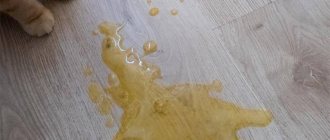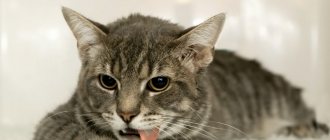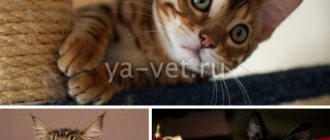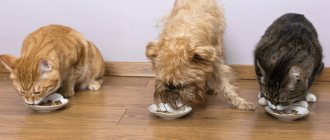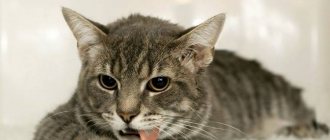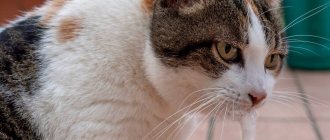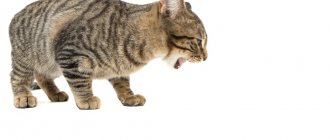Does your cat vomit after eating? Has your cat started vomiting often? What to give a cat for vomiting? What to feed a cat after vomiting? In this article we will answer these and other questions, understand the causes of frequent vomiting in a cat and learn how to take the necessary measures.
There is practically not a single animal owner in this world who has not at least once seen such a phenomenon as vomiting in their pet. Vomiting in a cat is a reflex process in which the contents of the stomach are expelled through the mouth, sometimes through the nose.
Abdominal muscles contract, strong salivation, and involuntary swallowing movements occur. The act of vomiting in a cat is regulated by the vomiting center, which is located in the medulla oblongata.
Animal owners do not always pay due attention to what happened, very often believing that it is simply the body’s reaction to food. Indeed, vomiting in a cat can have a completely simple reason that does not require examination by a veterinarian. But the difficulty lies precisely in the fact that the causes of vomiting in a cat are so varied that determining the truth can become a very difficult and time-consuming task.
Main reasons
The gag reflex always goes through 3 stages:
- Nausea. Accompanied by drooling, increased swallowing, licking the nose and lips. These are the first signs that your cat is about to vomit.
- Belching. The food is pushed up the esophagus and air comes out of the upper stomach.
- The contents of the stomach are released through the mouth. The duration of the process depends on the reasons.
Vomiting in a cat can be a consequence of toxins and poisons entering the bloodstream, acting on the area of the brain, the so-called vomiting center. In this case, mechanical irritation of the digestive tract occurs.
It is also possible that the causes of vomiting in a cat are related to an imbalance in the organ of balance. This happens to a person when he gets motion sickness in a car or while spinning on a carousel.
Nutrition
An unbalanced diet, cheap comas, complementary foods from the human table lead to diseases of the digestive system (gastroenteritis, gastritis), disorders of the liver and pancreas. Vomiting occurs both on an empty stomach and after eating; it may contain bile, undigested food, mucus, and foam.
Switching from natural food to dry food and vice versa can also cause unpleasant consequences.
Many pets eat milk with pleasure. However, it must be a specialized cat product. Cats do not have the enzymes to process cow's milk, so there is a risk of developing gastric problems.
Many owners do not control their pets' appetites, and cats love to eat. Cats are especially greedy for cheap food. There are too many “tasty” additives and flavorings. Overeating is a strain on the digestive organs, which often ends with the pet feeling sick and vomiting.
There are cats that eat every time like it’s their last. Rapid absorption leads to regurgitation of food. It is advisable to feed such pets in small portions, but more often. If there are several cats in the house, you need to make sure that one does not eat for the others.
Food allergies or intolerance to feed ingredients are also manifested by vomiting.
Worms
As a result of their vital activity, parasites poison the cat’s body, damage the walls of internal organs, and are one of the causes of vomiting. If the infestation is severe, the cat may regurgitate worms.
Wool
In long-haired breeds and those with a thick undercoat, fur is the most common reason why a cat might vomit. When self-grooming, the pet swallows hairs, which collect in a ball in the stomach. The owner may notice that the cat deliberately swallows something unrelated to food, then burps to clean out its stomach.
The hairball (trichobezoar) also has a direct effect on the walls of the stomach. The hairball can remain in the stomach for months or even years, causing vomiting. As a result, gastritis develops.
Trichobezoars cause intestinal obstruction. As a result, fecal stagnation occurs, which results in intoxication and vomiting. Therefore, it is important to comb long-haired cats regularly and give them pastes to remove hair. It is advisable for animals to follow a special diet for 2 weeks and undergo a course of treatment with gastroprotectors in order to restore the gastric mucosa damaged by hair balls.
Treatment. What to do.
First of all, remove food and water - food and liquid only cause additional irritation to the stomach.
If your cat has vomited once and you suspect regular overeating, it is enough to provide a break from food for 5-8 hours.
Water can be given a little at a time, but do not force the animal to drink.
The appearance of appetite is a good sign. But don’t rush to give your cat a full bowl of food. After fasting, food should be given in small portions so as not to harm the gastrointestinal tract. It is better to give often, but just a little at a time.
What to give your cat for vomiting
It is advisable for the first two to three days to follow a gentle diet with rice water, lean boiled chicken or special medicinal feed.
You need to gradually switch from a diet to your cat’s usual diet - remember this. Gradually add your usual food to your diet food until the ratio of your usual food to diet food is maximum.
Folk remedies for vomiting
A decoction of chamomile, which is given 3-4 times a day, 1-4 tablespoons, depending on the size of the cat, has a very good effect on the gastric mucosa. It is most convenient to use chamomile in bags, which you need to brew with boiling water and cool to room temperature. If the cat refuses to drink the broth, give it a drink through a syringe without a needle.
Flax seed decoction is another effective home remedy that is used in the same dosage as chamomile decoction.
We tell you how you can quickly and easily prepare it at home:
- pour 2 teaspoons of flax seeds into a pot or small ladle and pour a glass of boiling water over them;
- cook them for 10 minutes over low heat, stir;
- remove from heat and strain through a strainer;
- cool to room temperature.
Anti-vomiting medications
In case of repeated and severe vomiting in a cat, Cerucal or No-Shpu can be administered intramuscularly at the rate of 0.1 ml per 1 kg of animal weight.
Sorbents are also effective: Enterosgel, Atoxil. The use of electrolyte solutions such as Regidron for severe vomiting will be ineffective.
It is very important to consult a doctor if you experience severe or repeated vomiting, as self-medication can lead to disastrous results. The doctor will help determine the level of dehydration in the body, if necessary, insert an IV and determine the cause of vomiting.
Important!
It is strictly forbidden to self-medicate if you have a too young or, conversely, elderly animal. In this case, you should immediately consult a doctor.
Cerucal
The antiemetic drug Cerucal is produced in Croatia. It normalizes the tone of the digestive tract and works well for vomiting and nausea that occur due to impaired liver and kidney function, and head injuries. It is allowed to prescribe the drug as part of a complex treatment, simultaneously with taking other medications.
Vomiting of a vestibular nature cannot be stopped with Cerucal; for this pathology, it is necessary to prescribe other medications.
The active ingredient is metoclopramide hydrochloride.
Cerucal can be purchased both in tablet form and as an injection solution.
The drug in Ukraine costs from 200 hryvnia for tablets, solution - from 435 hryvnia, and in Russia - tablets from 98 rubles, solution for injection - from 230 rubles.
Atoxyl
IV generation enterosorbent has unique properties. Atoxil powder particles attach simultaneously to several bacterial cells, so the product agglutinates a large bacterial mass at once.
Veterinarians do not recommend giving Atoxil for a long time, as a side effect may occur - constipation in the animal.
The active ingredient is highly dispersed silicon dioxide.
A package of 20 sachets costs from 210 hryvnia in Ukraine. This powder for suspension is not sold in Russia.
Regidron
When a cat vomits, potassium, citrate, and sodium chloride are removed from the body. Regidron contains precisely these substances and glucose. The introduction of this drug into the course of treatment restores the correct balance of electrolytes and maintains the acid-base balance in the blood.
No side effects were noted when using Regidron.
In Ukraine, the drug (20 sachets) costs from 230 UAH, in Russia – from 390 rubles.
What do impurities in vomit mean?
The causes of vomiting can be assumed by the presence of impurities and the color of the contents:
- Vomited bile. Normally, there should be no bile fluid in the cat’s stomach, because it irritates the walls of the organ. If there is a yellow substance in the vomit and this is an isolated case, the cat may have eaten too much food or something fatty. In repeated cases, bile is a sign of problems with the liver and gall bladder.
- Green vomit in a cat. A sign of a large accumulation of bile in the animal’s stomach. The reason is related to infectious diseases. If the owner is absolutely sure that the greenish mass is not the result of eaten grass or other plants, urgent veterinary help is needed.
- Slime. Any type of gastritis, worms, viruses, intestinal problems can cause vomiting with mucus. With helminthic infestation, mucus is also observed in the feces.
- White foam. A single attack occurs when the cat has had a long break between meals. In this case there is no danger. However, if a cat often vomits transparent foam, it means there is a stomach disease.
- Blood. Dangerous condition. Scarlet bloody spots in the vomit are a sign of bleeding in the upper parts of the digestive tract (esophagus, mouth); brown impurity means the blood has reacted with gastric juice - a problem with the stomach (tumor, foreign object, ulcers), liver, duodenum.
- Presence of feces. Feces and foul odor in the gastric contents occur due to intestinal or gastric obstruction, abdominal injuries.
- Contains undigested food particles. Vomiting of food occurs due to poor quality food or overeating. If a cat vomits immediately after eating, then a possible cause is intestinal obstruction or loss of stomach muscle tone (atony). When the intestines are blocked, vomit erupts in a fountain and over a considerable distance. Such an eruption also occurs with increased intracranial pressure, as well as with pathologies of the brain. Vomiting containing undigested food long after feeding is a sign of anatomical disorders of the gastrointestinal tract, pancreatitis, and gastric paresis.
Vomiting a kitten
Vomiting in a kitten up to 2 months is evidence of the development of pathologies of the digestive system or low quality milk. If a nursing cat does not eat well, takes medications, or is sick, this is reflected in the composition of the nutritional fluid, which makes the kitten sick.
A common problem in the postpartum period is mastitis in cats. With a purulent form of inflammation of the mammary glands, milk becomes dangerous for kittens. It causes intoxication, the kitten vomits, and can lead to death.
In felines under the age of 2 months, while they are on mother's milk, the cause of vomiting is roundworms (nematodes). Kittens become infected with helminths from their mother while still in the womb. Small pets infected with parasites lag behind in development and slowly gain weight.
When a kitten vomits, it loses a lot of fluid. The situation is dangerous due to dehydration and low blood glucose levels. You cannot take measures on your own.
The field is 2-3 months old and in vaccinated kittens, vomiting occurs for the same reasons as in adult animals.
First aid
The animal must abstain from food for a day.
If an adult cat or kitten is constantly vomiting and it becomes noticeable that the condition is worsening, you should urgently take the pet to the veterinary clinic. If poisoning is suspected, it is important to stop the intake of toxins into the body and give the animal more water. It is also worth stopping feeding your cat if the condition does not improve within 24 hours after a fasting diet; it is dangerous to delay a visit to the doctor.
Pink vomit indicates internal bleeding. Giving your pet medications intended for humans is strictly prohibited. Here you will not be able to help the cat on your own; you only need medical help.
When to contact a veterinarian
You should try to get to the veterinarian as quickly as possible in the following cases:
- The food has been removed, but the vomiting does not stop, and the animal’s condition is depressed.
- Abnormal stool.
- The animal doesn't eat.
- Worms were found in the vomit.
- The cat is sick and vomits every day.
- The smell of vomit is foul and the mass looks like feces.
- Blood impurities.
- Vomiting is accompanied by elevated body temperature and convulsions.
- The kitten is vomiting.
